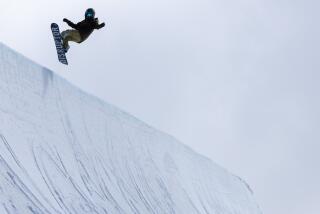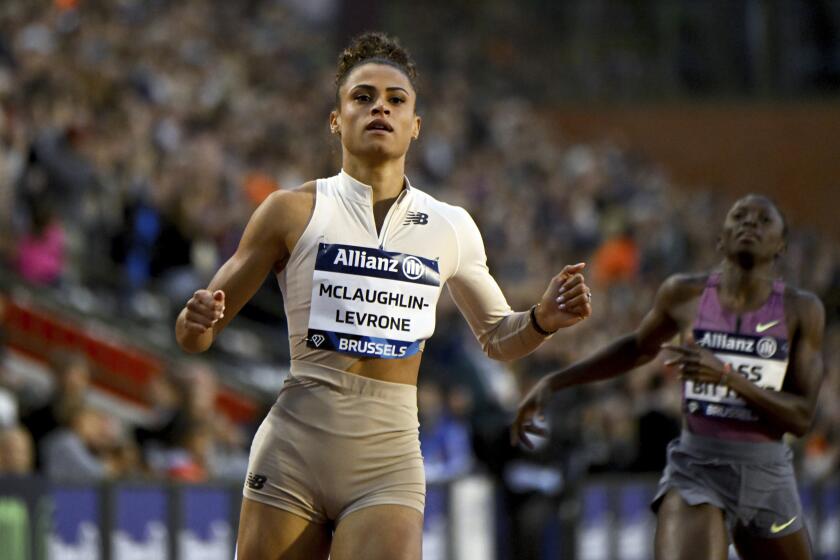World Cup Skiing : Stenmark Takes a Fall and Draws a Blank
- Share via
SOUTH LAKE TAHOE, Calif. — Ingemar Stenmark departed the ski-racing season by way of the side door Sunday. You had to be alert not to miss him.
After failing to capitalize on the third-fastest time in the first run of the men’s slalom Saturday by falling in the second run, the three-time World Cup overall champion from Sweden fell near the top of his parallel race against Austrian Anton Steiner Sunday and came up 0 for 1984-85.
Stenmark hung around long enough to pick up his trophy for finishing third in the World Cup slalom standings, then hurried off with his wife Anne to pack for the flight back to Europe.
For the first time in 11 seasons on the World Cup circuit, Stenmark was unable to win a race. He had 79 victories at the start--37 in slalom and 42 in giant slalom--and besides his three overall championships (in 1976-77-78), he had won the slalom title eight times, the giant slalom title seven times.
Stenmark, who finished sixth overall with 135 points, 127 behind champion Marc Girardelli of Luxembourg, turned 29 last week. Is it finally time for him to get off the White Circus’ carousel?
Said his teammate, Jonas Nilsson: “I don’t think he’s too old. If he really wants to ski fast, he still can. He has been racing for many years, and maybe his motivation is not what it used to be. He has won so many races that it must be difficult for him to train hard anymore.”
Stenmark, reticent as always, said only that he feels badly about this season, adding, “I’ve skied well in training but not in races. It’s a lot of things, but I don’t want to discuss them now.”
His Italian coach, Herman Nogler, thinks he knows what some of those things are.
Asked why Stenmark has skied so poorly this season, Nogler, who speaks little English, started gesturing to an interpreter and talking about the signora and the bambino .
There was little need for translation.
The Stenmarks’ baby didn’t make the trip to Heavenly Valley, remaining home with Ingemar’s in-laws in Stockholm.
Nogler indicated that Stenmark would race one more World Cup season but would probably not be around for the 1987 World Championships at Crans-Montana, Switzerland.
There is one qualification about 1985-86, however. If the International Ski Federation (FIS) approves the format of reversing the top 30 finishers in the second run of the slalom, Stenmark said he will retire. And he seems to be serious.
The proposed change was tried in the women’s slalom here Friday and was received enthusiastically by the spectators because of the prolonged suspense. Under current rules, only the top five are reversed, so the race is usually over after No. 5 (the first-run leader) has come down in the second run. The new system would make the first-run leader No. 30 in the second run.
Most racers, including Stenmark, think the change might be OK on a firm, well-prepared course and in good weather, as was the case here Friday, but ideal conditions are a rarity, especially in Europe. Most of the time, the course tends to deteriorate after the first 15 starters.
Hans Enn of Austria and Perrine Pelen of France won Sunday’s parallel races, which did not count in the World Cup standings but did figure into the final Nations’ Cup team totals.
Enn defeated Thomas Buergler of Switzerland in the men’s final, with Roc Petrovic of Yugoslavia taking third place.
Pelen beat Traudl Haecher of West Germany in the women’s final after edging Tamara McKinney of the United States in the semifinals. McKinney went on to outski Olga Charvatova of Czechoslovakia for third place.
Spring turned back into winter for the final day of competition in the World Cup Finals at Heavenly Valley. High winds preceded a snowstorm, which arrived shortly before the final runs. It continued throughout the presentation of the World Cup trophies by FIS President Marc Hodler.
The No. 1 man in international skiing was finally able to gain access to the finish area after spending the first two days watching from the general spectators’ area.
Hodler apparently neglected to pick up his credentials and was refused admittance by a security guard Friday.
“So, I just watched the races with everyone else,” he said. “I enjoyed doing it.”
Another spectator was Dr. Richard Steadman, a South Lake Tahoe resident who has treated the orthopedic problems of most of the world’s top ski racers, including current World Cup men’s overall champion Marc Girardelli.
The Austrian native who races for Luxembourg, had a knee repaired by Steadman after injuring it in the spring of 1983 at Lake Louise, Canada. He was back on skis by late summer and eventually placed third overall in the 1983-84 World Cup standings, while winning the slalom title.
Steadman’s latest patient was Bill Johnson, America’s 1984 Olympic downhill champion, who underwent arthroscopic surgery on his left knee Thursday.
“We just cleaned out a little cartilage,” Steadman said. “It was nothing serious, just something that had been building up over a period of time.
Johnson, who failed to win a race this season, will get his next chance to show that 1984 wasn’t a fluke in three downhills scheduled for South America Aug. 17, 24 and 31, all of which will count toward the 1985-86 World Cup.
The complete World Cup schedule for next season won’t be set until the FIS Congress at Vancouver, Canada, in late May.
One proposal will be to start the season next fall in the United States, go to Europe for most of the winter, then return to North America in the spring.
The shortage of snow in the Alps last November and December, which caused the cancellation of several races, was not a unique situation. It’s happened before. And Colorado resorts, such as Copper Mountain, are eager to move in, pointing out that they generally have reliable snow by Dec. 1, or if nothing else, can cover a race course with snowmaking.
More to Read
Go beyond the scoreboard
Get the latest on L.A.'s teams in the daily Sports Report newsletter.
You may occasionally receive promotional content from the Los Angeles Times.






